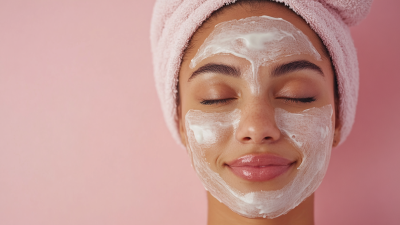
News
5 Reasons Azelaic Acid is the Best Skincare Ingredient You Need
In recent years, Azelaic Acid has gained significant attention in the skincare industry, and for good reason. This powerful ingredient, derived from grains, has been clinically shown to effectively treat a range of skin concerns, including acne, rosacea, and hyperpigmentation. According to a study published in the Journal of the American Academy of Dermatology, Azelaic Acid exhibits anti-inflammatory and antibacterial properties, making it a preferred choice for individuals with sensitive skin or those seeking to manage breakouts. Additionally, the global skincare market is projected to reach $189.3 billion by 2025, with active ingredients like Azelaic Acid playing a pivotal role in the formulation of effective products. With its multifaceted benefits and gentle nature, it’s no wonder that beauty enthusiasts and dermatologists alike are championing Azelaic Acid as a must-have component in any effective skincare regimen.

Benefits of Azelaic Acid for Acne Treatment: Understanding Its Efficacy in Clinical Studies
Azelaic acid has garnered attention in skincare, particularly for its efficacy in treating acne. Clinical studies reveal that azelaic acid can significantly reduce the number of acne lesions and diminish redness associated with inflammation. A study published in the Journal of Dermatology found that 20% azelaic acid cream improved overall acne lesions by approximately 50% over 12 weeks. This is particularly noteworthy as azelaic acid is a versatile ingredient that works on various acne types, including hormonal and cystic acne.
One of the key benefits of azelaic acid is its ability to target both the acne bacteria, Propionibacterium acnes, and the skin's hyperpigmentation often left behind as a result of acne. According to research in the American Journal of Clinical Dermatology, treatment with azelaic acid not only reduces acne but also minimizes post-inflammatory hyperpigmentation, making it an ideal choice for those prone to dark spots after breakouts.
**Tips:** If you're considering azelaic acid for acne treatment, start with a lower concentration to gauge your skin's reaction. Ensure to incorporate it into your evening skincare routine, as it can enhance skin tolerance and minimize irritation. Always pair it with a suitable moisturizer, especially if you're using other active ingredients like retinoids.
Benefits of Azelaic Acid for Acne Treatment
This chart illustrates the various benefits of Azelaic Acid for acne treatment, showcasing its efficacy in reducing inflammation, redness, and improving overall skin texture based on clinical observations. The efficacy is rated on a scale of 1 to 10, highlighting the potential of Azelaic Acid in skincare routines aimed at managing acne.
Azelaic Acid's Role in Reducing Hyperpigmentation: Insights from Dermatological Research
 Azelaic acid has emerged as a powerful ally in the battle against hyperpigmentation, a common skin concern that affects individuals of all skin types. According to a study published in the Journal of the American Academy of Dermatology, a consistent application of azelaic acid reduces melasma, a type of hyperpigmentation, by up to 50% over 12 weeks. This ingredient works by inhibiting tyrosinase, an enzyme crucial for melanin production, thereby helping to even out skin tone and reduce dark spots.
Azelaic acid has emerged as a powerful ally in the battle against hyperpigmentation, a common skin concern that affects individuals of all skin types. According to a study published in the Journal of the American Academy of Dermatology, a consistent application of azelaic acid reduces melasma, a type of hyperpigmentation, by up to 50% over 12 weeks. This ingredient works by inhibiting tyrosinase, an enzyme crucial for melanin production, thereby helping to even out skin tone and reduce dark spots.
Furthermore, dermatological research indicates that azelaic acid is not only effective but also well-tolerated by sensitive skin. A clinical trial in the British Journal of Dermatology showed that patients reported minimal side effects compared to traditional hydroquinone treatments, making azelaic acid a safer alternative for long-term use. With its dual action of exfoliating and anti-inflammatory properties, azelaic acid is not only addressing existing pigmentation issues but also preventing their formation, solidifying its position as a cornerstone ingredient in effective skincare routines.
The Anti-Inflammatory Properties of Azelaic Acid: Evidence-Based Benefits for Sensitive Skin
Azelaic acid has garnered widespread acclaim for its remarkable anti-inflammatory properties, making it an ideal choice for individuals with sensitive skin. This dicarboxylic acid works by reducing redness and irritation, helping to soothe conditions like rosacea and acne. Research indicates that azelaic acid can inhibit the production of inflammatory mediators, allowing for a calmer complexion. Its ability to promote cell turnover also aids in preventing clogged pores, further enhancing its effectiveness for those prone to breakouts.

When incorporating azelaic acid into your skincare routine, start by using a product with a lower concentration to let your skin acclimate. Apply it at night on clean, dry skin, followed by a gentle moisturizer. This will help to minimize any potential irritation while maximizing the ingredient's anti-inflammatory benefits. Remember, consistency is key; use it regularly for the best results.
Additionally, layering azelaic acid with ingredients like niacinamide can further enhance its soothing properties. Always conduct a patch test before introducing new products, and consider consulting with a dermatologist if you have existing skin conditions. With its versatile benefits, azelaic acid can be a game-changer for sensitive skin types seeking relief and a more even complexion.
Comparative Analysis: Azelaic Acid vs. Other Common Skincare Ingredients
When comparing azelaic acid to other common skincare ingredients, it stands out due to its multi-faceted benefits. Unlike alpha hydroxy acids (AHAs), which primarily exfoliate the surface of the skin, azelaic acid penetrates deeper to reduce inflammation and bacteria, making it particularly effective for acne-prone skin. This dual-action makes it a preferred choice for those looking to treat existing breakouts while also preventing future ones.

Another notable comparison is with retinoids, known for their anti-aging properties. While retinoids can be potent, they often come with side effects like irritation and peeling. Azelaic acid, on the other hand, is gentle enough for sensitive skin types and can be used in conjunction with other treatments without causing excessive dryness. Moreover, unlike many other active ingredients, azelaic acid has been shown to even out skin tone and reduce hyperpigmentation, positioning it as a versatile option in the skincare arsenal.
Long-Term Use of Azelaic Acid: Dermatologists' Recommendations and Safety Profiles
When considering skincare routines, the long-term use of azelaic acid has garnered significant attention from dermatologists. This ingredient is praised for its multiple benefits, including reducing acne, minimizing rosacea symptoms, and brightening skin tone. Dermatologists often recommend incorporating azelaic acid gradually into your daily regimen to assess how your skin responds, which helps avoid potential irritation commonly associated with new products.
Tips for using azelaic acid effectively include starting with a lower concentration and slowly increasing it as your skin builds tolerance. Using it in conjunction with a good moisturizer can help mitigate dryness. Additionally, applying it at night is beneficial, allowing the ingredient to work while you sleep and minimizing sun sensitivity during the day.
As for safety profiles, azelaic acid is generally well-tolerated across various skin types, making it a versatile option for many. If you have sensitive skin, patch testing before full application is advisable. Regular use, as recommended by dermatologists, can lead to noticeable improvements without the harsh side effects linked to other active ingredients. Embrace these tips to maximize the benefits of azelaic acid in your skincare journey.
5 Reasons Azelaic Acid is the Best Skincare Ingredient You Need - Long-Term Use of Azelaic Acid: Dermatologists' Recommendations and Safety Profiles
| Reason | Benefits | Long-Term Use Safety | Dermatologists' Recommendations |
|---|---|---|---|
| Reduces Acne | Helps clear current acne and prevent future breakouts. | Generally safe for long-term use, with minimal side effects. | Highly recommended for individuals with acne-prone skin. |
| Brightens Skin Tone | Evens out skin tone and reduces the appearance of hyperpigmentation. | Tolerated well by sensitive skin types, making it a safe option. | Recommended for treating melasma and post-inflammatory hyperpigmentation. |
| Anti-Inflammatory Properties | Reduces redness and inflammation associated with rosacea. | Well-studied for long-term effects in managing rosacea. | Preferred by dermatologists for rosacea management. |
| Non-Irritating | Gentle formulation suitable for all skin types, including sensitive skin. | Low incidence of irritation and discomfort over prolonged use. | Advised for patients who have experienced irritation from other treatments. |
| Versatile Ingredient | Effective for multiple skin concerns, including acne, pigmentation, and rosacea. | Considered safe when combined with other active treatments. | Often suggested as part of a comprehensive skincare regimen. |
Related Posts
-

Global Trust in Premier Azelaic Acid: Exceptional Manufacturing from China
-

5 Unique Benefits of Azelaic Acid for Global Buyers
-

Ultimate Guide to Sourcing Vitamin C Coated Products for Global Buyers
-

Exploring Best Phytic Acid Alternatives for Global Buyers in the Nutraceutical Industry
-

Exploring Industry Applications of Best Ethyl Acetate and How to Maximize Its Benefits
-

Mastering Neomycin Sulfate Application Techniques for Optimal Results





